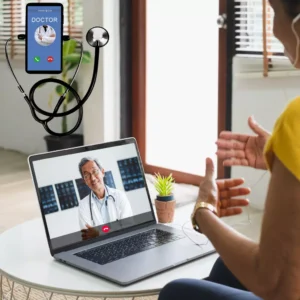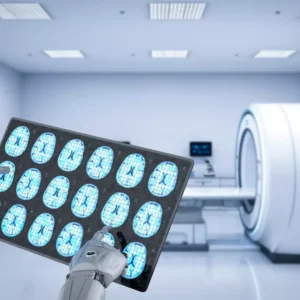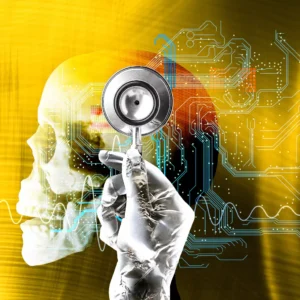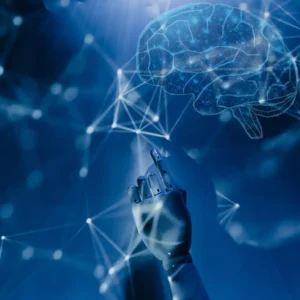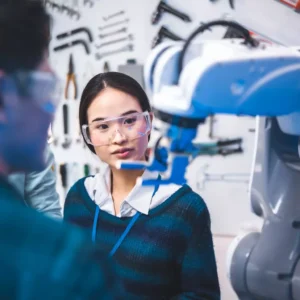
Smart Hospitals
The Role of AI in hospital operations
The advent of AI in the healthcare sector is not just a wave; it’s a transformation. From simplifying intricate hospital operations to predicting patient flow, AI’s footprint is evident.
Gone are the days of prolonged wait times, thanks to the precision and efficiency of AI. This article will unravel how AI-driven resource allocation sets new benchmarks and how IoT integration amplifies these benefits.
We’ll walk you through a real-life success story of an innovative hospital, offering a glimpse into the future. However, like any tech evolution, challenges arise. We’ll delve into the hurdles hospitals face, emphasizing the importance of staff training in this AI-driven era.
Join us in visualizing the future of hospital management powered by AI. Let’s begin this insightful journey.
Table of Contents
Introduction to AI in Hospital Operations
The modern hospital is not just a place of healing; it’s a complex, dynamic environment demanding precise coordination and efficiency. Enter AI in hospital operations, an evolution that promises to streamline and revolutionize healthcare. Leveraging artificial intelligence, hospitals now harness data-driven insights to optimize every aspect of their functioning.
From predictive patient flow management, which anticipates patient needs and streamlines their journey, to intelligent systems that play a pivotal role in reducing patient wait times, AI is proving its mettle. Imagine the power of algorithms that can forecast patient influx during specific hours or even predict potential health outbreaks based on gathered data!
Furthermore, AI-driven resource allocation ensures that human and material resources are utilized to their maximum potential. With the integration of IoT with hospital AI systems, the scope has expanded beyond comprehension. Devices talk to each other, monitoring patient vitals in real-time and alerting medical professionals of any anomalies.
This isn’t just an operational enhancement. It’s an enhanced patient experience with AI, offering tailored care solutions, faster responses, and improved outcomes. In this landscape, hospitals aren’t just curing; they’re predicting, personalizing, and pioneering a new healthcare age.
Role of AI in Modern Radiology
Radiology has always been at the forefront of medical technology, and now it’s experiencing a transformative shift with the introduction of AI in hospital operations. Today, AI-powered algorithms assist radiologists in detecting anomalies with far greater accuracy than ever. These advanced systems highlight potential areas of concern on X-rays, MRIs, or CT scans and reduce the chances of human error, a breakthrough crucial for early disease detection.
Moreover, predictive patient flow management within radiology departments ensures optimal scheduling, reducing patient wait times. As more images are fed into AI systems, their learning and accuracy improve, a classic example of machine learning in action. Additionally, AI-driven resource allocation allows hospitals to manage and maintain radiology equipment efficiently, ensuring it’s used optimally and reducing downtimes.
Another leap is the integration of IoT with radiology AI systems. Devices can now seamlessly communicate, storing and sharing crucial patient imaging data across platforms. This interconnected ecosystem provides a more comprehensive view of patient health. The enhanced patient experience with AI in radiology ensures better diagnostic results and fosters trust in the medical process. As we witness the fusion of AI and radiology, the horizon of healthcare technology looks promising.
Innovations in Patient Flow Management
In a bustling hospital setting, ensuring smooth patient flow is paramount. Enter the groundbreaking innovations brought by AI in hospital operations. No longer is patient management reliant solely on human judgment; now, it’s backed by data, analytics, and intelligent forecasting.
One of the most impressive breakthroughs is predictive patient flow management. Imagine a hospital system that can predict when you’re most likely to need medical attention. With historical data and advanced analytics, healthcare facilities can forecast patient influxes, ensuring they’re fully prepared for peak times or seasonal outbreaks. It’s just one-way technology is helping hospitals provide better care and support for their patients. Such forecasts directly reduce patient wait times, a key metric in patient satisfaction.
The magic doesn’t stop there. AI-driven resource allocation ensures that the right resources – beds, equipment, or staff – are in the right place at the right time. This optimization creates a swifter, more seamless patient experience and less chaotic shifts for healthcare professionals.
The benefits of these innovations also ripple out to enhancing the patient experience with AI. With real-time tracking and insights into patient movement and needs, individual care pathways are tailored, ensuring every patient receives timely and apt care. In the grand tapestry of hospital management, AI is weaving patterns of efficiency, foresight, and adaptability, genuinely shaping the future of healthcare.
Addressing the Challenge of Wait Times
Long wait times have often been a sore point in the realm of healthcare, with both patients and providers seeking solutions. With the integration of AI in hospital operations, this chronic challenge is finally being addressed head-on. The beauty of AI lies in its ability to analyze patterns, predict trends, and optimize resources, all of which directly influence wait times.
Predictive patient flow management is a game-changer. Hospitals can adjust staffing levels and proactively allocate resources by forecasting busy periods and patient demands. This predictive approach ensures that patients are attended to promptly, drastically reducing wait times.
Beyond predictions, real-time analytics play a significant role. AI-driven resource allocation monitors ongoing hospital activity, making on-the-fly adjustments. Think of it as an intelligent traffic management system, ensuring that patient flow remains smooth and bottlenecks are swiftly addressed.
Another feather in AI’s cap is the integration of IoT with hospital AI systems. Devices that monitor patient vitals can signal when a patient needs immediate attention, ensuring timely care. This proactive approach enhances the patient experience with AI and reinforces trust in the healthcare system. Are you tired of wasting precious time on healthcare? Look no further than AI, the ultimate time-saving champion of the modern age. With its advanced technology and superior efficiency, AI is transforming the healthcare industry and ensuring every second counts.
Resource Allocation and Efficiency
The judicious use of resources is at the heart of any successful hospital operation. With the infusion of AI in hospital operations, the landscape of resource management is undergoing a dynamic transformation. It’s no longer about mere allocation; it’s about intelligent, precise, and timely distribution of resources.
Central to this paradigm shift is AI-driven resource allocation. Gone are the days of static schedules and rigid resource plans. Today’s AI-powered systems analyze real-time data, gauging hospital needs instantaneously. Whether redistributing medical staff during a sudden influx of patients or ensuring that critical equipment is available at peak demand times, AI streamlines these decisions with unparalleled efficiency.
The ripple effects of this efficiency are profound. Reducing patient wait times becomes a tangible reality, as does enhancing the overall patient journey. Another noteworthy advancement is the integration of IoT with hospital AI systems. When medical devices can communicate, sharing usage data and availability, it further sharpens the precision of resource distribution.
AI’s foray into resource management is about more than just allocation. It’s about maximizing the potential of every asset, every moment, and every opportunity. In the demanding world of healthcare, this efficiency is not just desired; it’s imperative.
Role of IoT and Interconnected Devices
The interconnected web of the Internet of Things (IoT) is the unsung hero in the narrative of AI in hospital operations. While AI provides the brains, the IoT offers the senses, capturing data and insights from every corner of a hospital setting.
With IoT integrated with hospital AI systems, there’s an ongoing, real-time data exchange. Imagine a bed alerting the system when it’s free or a medical device signalling its maintenance needs ahead of time. These interconnected devices streamline operations and elevate preventive care to a new high.
Predictive patient flow management benefits immensely from this. Sensors can track patient movement, ensuring optimal flow and reducing wait times. Moreover, AI-driven algorithms, fed with continuous data from IoT devices, can predict equipment failures or maintenance needs, optimizing AI-driven resource allocation and reducing potential downtimes.
Beyond operational efficiency, the true gem lies in enhancing the patient experience with AI. When wearable patient monitors communicate seamlessly with central systems, it ensures timely medical interventions and personalized care pathways.
Case Study: A Smart Hospital Success Story
In the heart of Singapore stands the Beacon Hospital, a shining example of AI in hospital operations. Just a few years ago, this establishment faced challenges in patient management, extended wait times, and sub-optimal resource allocation. Today, it stands transformed, all thanks to AI and IoT integration.
Beacon’s transformation began with the implementation of predictive patient flow management. Leveraging AI, the hospital could foresee busy periods and allocate staff more effectively, playing a pivotal role in reducing patient wait times. Once brimming with anxious patients, the waiting area now exudes a calm efficiency.
But the real magic was in Beacon’s integration of IoT with their AI system. Medical devices, beds, and lighting systems began communicating, offering real-time data insights. This interconnected network was crucial for AI-driven resource allocation, ensuring that every piece of equipment was utilized to its fullest potential.
The outcome? Enhanced operational efficiency and a markedly improved patient experience. Feedback scores skyrocketed, with patients highlighting the seamless care they received. Beacon Hospital’s journey is not just a testament to the power of AI in healthcare but also a beacon (pun intended) for hospitals worldwide, showcasing the tangible benefits of intelligent hospital operations.
Training and Upskilling Hospital Staff
As the wave of AI in hospital operations surges, it brings forth not just technological change but a paradigm shift in the roles and responsibilities of hospital staff. With AI systems enhancing efficiency, the need to upskill and train staff becomes paramount to harness these advancements fully.
Central to this journey is understanding that AI doesn’t replace human roles but amplifies them. For instance, nurses with insights from predictive patient flow management can prepare better for their shifts, anticipating busy hours and potential challenges. However, this requires training them to interpret and act on these insights.
Upskilling programs focus on integrating AI-driven resource allocation knowledge, ensuring that staff can navigate and collaborate with AI tools seamlessly. Workshops on IoT and interconnected devices empower them to harness real-time data, improving patient care quality.
Beyond the technical, training also encompasses fostering a mindset shift. Emphasizing the goal of enhancing patient experience with AI ensures that staff see AI as an ally, not a replacement.
In the grand tableau of AI-powered hospitals, the human element remains irreplaceable. By upskilling and training, hospitals ensure that their staff is not just keeping pace with technological advancements but spearheading the revolution in patient care.
Overcoming Implementation Challenges
Delving into the realm of AI in hospital operations is no small endeavour. While the promise of streamlined processes and enhanced patient care is alluring, it comes with challenges during implementation. However, these hurdles can be elegantly navigated with foresight and strategic planning.
One of the primary challenges is data integrity. AI thrives on accurate data, and ensuring consistency in data input across departments is crucial. Regular audits and staff training on the importance of precise data capture can address this.
Then comes the obstacle of resistance to change. Traditional staff might view AI-driven resource allocation or IoT integration with scepticism. Addressing this requires transparent communication, showcasing success stories, and emphasizing the goal of enhancing patient experience with AI.
Budget constraints, too, can pose challenges. Here, pilot projects can be beneficial. Starting small, showcasing tangible benefits, and scaling can convince stakeholders of the long-term advantages and ROI.
Ensuring the proper infrastructure and addressing compatibility issues between existing systems and new AI tools is vital. Partnering with the right technology vendors can make this transition smoother.
While challenges in AI adoption in healthcare are undeniable, with a structured approach and commitment to excellence, they are stepping stones to a more innovative, more efficient future.
Vision for Future Smart Hospitals
Imagine a world where hospitals are not just centres of healing but epitomes of efficiency and innovation. The integration of AI in hospital operations is paving the way for this vision, heralding the era of truly smart hospitals.
In the future, as AI matures, we’ll witness a seamless blend of human touch and technology. Predictive patient flow management will ensure that every patient’s journey is smooth, from admission to discharge. It won’t just reduce patient wait times; it’ll be about eliminating them.
Further, integrating IoT with hospital AI systems will evolve. Devices won’t just communicate; they’ll predict, adapt, and self-regulate. A bed will adjust autonomously to a patient’s comfort needs, and operating rooms will prepare themselves for surgeries based on the patient’s unique requirements.
Training will transform, too. It won’t just be about upskilling for AI-powered hospitals but about fostering innovators and thinkers who will lead the next wave of AI advancements.
However, the heart of this vision remains the same: patient well-being. Every AI tool and interconnected device will work with one goal: enhancing patient experience with AI.
In essence, the intelligent hospitals of the future won’t just be technologically advanced; they’ll be patient-centric utopias, setting golden standards in healthcare globally.
In Conclusion
The journey towards integrating AI in hospital operations is transformative, steering healthcare into an era of unprecedented efficiency and patient-centric approaches. Through predictive analytics, hospitals are taking strides in optimizing patient flow management, thereby reducing wait times and enhancing the overall patient experience.
The pivotal role of IoT and interconnected devices cannot be overlooked, weaving a network of intelligent systems focused on responsive and adaptive care. While challenges in implementing these technologies are real, success stories offer a glimpse into the remarkable potential that lies ahead.
A focus on staff training and strategizing against potential hurdles is vital to ensure a seamless transition into this futuristic model. The overarching vision portrays smart hospitals as healing institutions and entities synonymous with innovation, patient comfort, and efficiency.
As we stand on the threshold of this revolution, we must foster a collaborative environment where technology and humanity coalesce, paving the path for a healthcare ecosystem that is not just smart but wise, considerate, and profoundly humane.
Related Articles
- AI in Telehealth: Revolutionizing Remote Care
- Navigating the Next: AI’s Role in Healthcare Predictive Analytics
- Transforming Medical Imaging with AI Capabilities in Radiology
- AI in Genetic Data Analysis: Personalizing Medicine
- AI in Diagnostics: A New Era of Precision and Accuracy
- Smart Hospitals: The Role of AI in hospital operations
- Mental Health Tech: AI-powered Mental Health Apps for Assessment and Therapy
- AI-Powered Drug Discovery: A Revolution in Pharma
- Medical Robots Enhanced by AI: Transforming Surgeries and Care
- Wearable Health Tech: AI-driven health wearables
- AI’s role in chronic disease management
- Neural Interfaces and AI: Bridging Minds and Machines
- Digital Health Platforms: The Power of AI Integration
- AI in Epidemiology: Predicting and Controlling Outbreaks
- AI in Rehabilitation: Personalized Recovery Pathways
- AI in Predictive and Preventive Care: A Proactive Approach
- AI in Home Healthcare: Personal Health Management
- Revolutionise Healthcare with IPA Tools: Streamlining Processes, Improving Efficiency, and Enhancing Patient Care
- Other Articles on AI Usage in Healthcare
- Other Articles on AI usage in different industries

Arindam Roy
An Automation Consultant with 25+ years of IT Experience
Forbes Articles related to AI usage in Healthcare:

